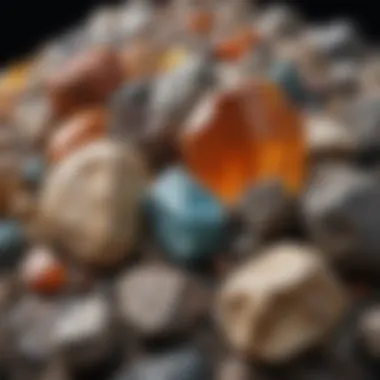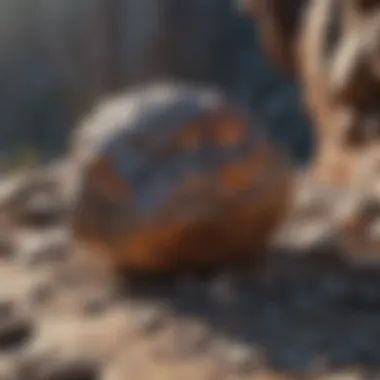Composition of Rock: Exploring Its Fundamental Elements


Intro
The composition of rocks is a foundational aspect of geology that reveals much about our planet's history and structure. Understanding these components is essential for rock and fossil collectors as well as for anyone interested in geology. Rocks are not merely inert substances; they tell a story of nature's processes over millions of years. From their mineral makeup to the methods of formation, the details of rock composition hold significant value in various fields, including construction, environmental science, and education.
History and Origins
Overview of Collectibles, Rocks, and Fossils
The history of rocks and fossils extends back to the dawn of Earth. Rocks serve as a record of geological time, collecting data from processes such as volcanic activity and sedimentation. Fossils, on the other hand, capture a snapshot of ancient life, preserving the remains of organisms that once inhabited our planet. Collections often begin with a child's fascination and grow into lifelong pursuits. Museums and private collectors showcase rare rocks and fossils, illustrating not just their beauty but their historical significance.
Historical Significance and Cultural Impact
Throughout history, rocks have influenced culture, architecture, and technology. Cultures have held significant beliefs about specific stones, often attributing spiritual power or healing properties to them. For instance, granite and marble have been used for monuments, while limestone has shaped many ancient buildings. The durability and aesthetic qualities of various types of rock have made them vital in human endeavors.
Rocks also provide insights into the Earth's evolution. Scientists study rock layers to understand climate changes and mass extinctions. Geologists can unravel past environments by analyzing sedimentary rocks, making them key to comprehending Earth's dynamic processes.
Identification and Classification
Guide to Identifying Rocks and Fossils
Identifying rocks and fossils requires an understanding of their distinct characteristics. Key factors include:
- Color: This may indicate the mineral composition.
- Texture: Fine or coarse textures can suggest how the rock formed.
- Hardness: This can be measured using the Mohs hardness scale.
Amateur collectors should start with basic tools such as a hand lens, a streak plate, and a hardness kit. Observing these properties helps in categorizing specimens accurately.
Common Types and Variations
There are three main types of rocks:
- Igneous Rocks: Formed from cooled molten material. Examples include basalt and granite.
- Sedimentary Rocks: Created from the accumulation of sediments. Examples include sandstone and limestone.
- Metamorphic Rocks: Result from the alteration of existing rocks under heat and pressure. Examples include schist and marble.
Each rock type has various variations influenced by the geological environment and the processes involved in their formation. Understanding these classifications enriches a collector’s perspective and appreciation for rock specimens.
"Rocks are the keys to understanding the planet's past, present, and future."
Prelude to Rocks
In the study of geology, the foundational concept of rocks cannot be overemphasized. Understanding rocks is fundamental to various scientific disciplines, connecting us to Earth’s past, present, and future. This article aims to illuminate the intricate composition of rocks, exploring their essential components, formation processes, and classification systems.
Defining Rocks
Rocks are naturally occurring solid aggregates composed of one or more minerals or mineraloids. Their definition encompasses a broad range of formations, including those that originate from volcanic activity, sediment deposition, or metamorphic transformation. Typically, rocks can be categorized into three major types: igneous, sedimentary, and metamorphic, each characterized by distinct formation processes and mineral compositions.
Rocks possess unique physical properties, such as texture and mineral composition, which can provide valuable insight into their history and origin. For example, igneous rocks formed from cooling magma often exhibit a crystalline texture, while sedimentary rocks are often layered, indicating a history of deposition. This differentiation not only enriches our understanding of geology but also aids in the identification of natural resources.
Importance of Studying Rocks
The significance of studying rocks extends far beyond mere classification. Rocks are repositories of Earth's history, revealing information about past climates, geological events, and the evolution of life. They provide essential insights into the planet's processes and cycles.
Some key reasons for studying rocks include:
- Resource Management: Many rocks contain valuable minerals and resources that are crucial for human activities, such as construction, technology, and energy production. Understanding their composition helps in efficient resource extraction.
- Earth's History: By analyzing rock formations, scientists can reconstruct past environments and geological events, shedding light on how the planet has changed over millions of years.
- Natural Hazard Prediction: Studying the characteristics of certain rock types can assist in predicting geological hazards, such as earthquakes and volcanic eruptions.
"Rocks are not just solid objects; they are the chronicles of Earth’s history, offering clues to understanding our planet’s past and guiding its future."
Minerals: The Building Blocks of Rocks
Understanding minerals is vital for comprehending rock composition. Minerals are the individual components that combine to form rocks. Each mineral has its own unique properties, and their interactions lead to the complexity of rock formations. By studying minerals, we gain insights into the geological processes that shape the Earth. These components influence everything from the physical characteristics of rocks to their economic significance.
In geology, the term mineral refers specifically to naturally occurring, inorganic solids with a defined chemical composition and crystal structure. The importance of minerals cannot be overstated. They are essential not only in the formation of rocks but also in various industries and ecosystems.
What Are Minerals?
Minerals are defined as naturally occurring substances composed of one or more chemical elements. Their characteristics are categorized based on physical and chemical properties. Some common attributes include hardness, color, luster, and density. These properties can help identify and classify minerals effectively.
For example, quartz is one of the most abundant minerals in the Earth’s crust. It exhibits a hardness of 7 on the Mohs scale and is commonly found in many rock types. On the other hand, feldspar, which comes in various forms, is also prevalent and plays a major role in the composition of igneous rocks.
Key Properties of Minerals:


- Color: Easily observed but may vary in different samples.
- Streak: The color of a mineral in powdered form, often more consistent than color alone.
- Luster: Refers to how light interacts with the surface of the mineral—can be metallic or non-metallic.
- Hardness: Resistance to scratching, determined using the Mohs scale.
- Cleavage and Fracture: Describes how a mineral breaks, either along defined planes or irregularly.
Classification of Minerals
Minerals can be classified based on their chemical composition. Broadly, they fall into two categories: silicate and non-silicate minerals. Silicates contain silicon and oxygen in their structure, making them the most abundant group in the Earth’s crust. Non-silicates include a range of minerals that do not follow this structure.
- Silicate Minerals:
- Non-Silicate Minerals:
- Examples include quartz, feldspar, and mica.
- Silicates are further divided into groups such as ferromagnesian and non-ferromagnesian based on their iron and magnesium content.
- These include carbonates like calcite, and oxides like hematite.
- They often play critical roles in economic geology and are key for resource extraction.
"Studying minerals unlocks the door to understanding Earth's complex geological history and its resources."
Links for more information: Wikipedia on Minerals, Britannica on Mineral Classification, Reddit Mineral Collecting.
Types of Rocks
The classification of rocks into three main types is essential for understanding the processes that shape the Earth. Rocks can be divided into igneous, sedimentary, and metamorphic types. Each category has distinct formation processes, characteristics, and examples that illustrate the diversity of Earth's crust. This section emphasizes the significance of these categories, explaining how they contribute to our comprehension of geological phenomena.
Igneous Rocks
Formation Process
Igneous rocks form through the cooling and solidification of molten material called magma, which originates from the Earth's interior. There are two primary formation processes: intrusive and extrusive. Intrusive igneous rocks, such as granite, form when magma cools slowly beneath the Earth’s surface. This slow cooling allows for the formation of larger crystals, resulting in a coarse-grained texture. On the contrary, extrusive igneous rocks, like basalt, form from magma that erupts onto the surface through volcanic activity. Here, the rapid cooling leads to a fine-grained texture, with small or no visible crystals.
The distinction between intrusive and extrusive processes is significant within geology. Understanding these processes helps explain the variations in rock texture and mineral composition. Additionally, recognizing how these rocks interact with the environment sheds light on their formation under specific geological conditions.
Common Examples
Typical examples of igneous rocks include granite and basalt, each showcasing unique characteristics. Granite is known for its light-colored appearance and grainy texture. It is often used in construction because of its durability and aesthetic appeal. In contrast, basalt is dark, dense, and commonly found in oceanic crust. Its high iron and magnesium content give it distinctive properties that are important in various geological applications.
Both granite and basalt serve as excellent examples that reflect the different cooling histories of igneous rocks. They demonstrate how varying mineral content and cooling rates affect rock characteristics, which is relevant for aspiring geologists and collectors.
Sedimentary Rocks
Formation Process
Sedimentary rocks are formed from the accumulation and compaction of mineral and organic particles, often in bodies of water. Processes such as weathering break down existing rocks into smaller fragments known as sediments, which can include clay, sand, and silt. Over time, these sediments are deposited in layers, where they experience compaction and cementation. Common processes like lithification are crucial in transforming loose sediments into solid rock.
Sedimentary rock formation is vital in understanding Earth's history, as it often contains fossils that provide insights into past environments. This nature of sedimentary rocks makes them a robust category for studying paleoenvironments and past climatic conditions.
Common Examples
Sandstone and limestone are well-known examples of sedimentary rocks. Sandstone is composed primarily of sand-sized mineral particles, characterized by its porous nature, which allows for significant water retention. This feature makes it valuable in groundwater management.
Limestone, predominantly made of calcium carbonate, often forms from biological material, like coral. Its unique formation process allows it to act as both a record of biological history and a key resource in the construction and agriculture fields.
Both sandstone and limestone highlight the impact of sedimentary processes. Their formation makes them significant in environmental studies and has practical applications that extend to economic factors.
Metamorphic Rocks
Formation Process
Metamorphic rocks arise from the transformation of existing rock types through heat, pressure, and chemically active fluids. This process, known as metamorphism, alters the mineral composition and structure of the original rock, referred to as the parent rock. This can occur either through regional metamorphism, where large areas are subjected to high pressure and temperature, or contact metamorphism, where rocks are heated by nearby molten material.
The metamorphic process displays the adaptive capabilities of rocks under varying environmental conditions. Learning about these processes deepens understanding of Earth's dynamic nature and the factors influencing rock transformation.
Common Examples
Common metamorphic rocks include schist and marble. Schist is characterized by its foliated texture, often containing visible layers and minerals like mica. This property gives it a unique aesthetic appeal, making it a choice material for design and decoration.
Marble, on the other hand, is a metamorphosed form of limestone. It is prized for its beauty and durability, frequently used in sculptures and buildings. Understanding these rocks helps in appreciating their uses in art and construction, showcasing how metamorphic processes contribute to societal progress.
By emphasizing their formation processes and common examples, it becomes clear that the study of rocks goes beyond scientific inquiry. It intertwines with practical applications, historical significance, and environmental understanding.
Rock Formation Processes
Understanding rock formation processes is essential in geology. It provides insight into how rocks are created, transformed, and recycled over time. Knowing these processes helps us comprehend Earth’s dynamic systems and the history recorded in various rock types.


The Rock Cycle
The rock cycle is a fundamental concept that illustrates the continuous transformation of rocks. It explains how rocks change from one type to another through various geological processes. This cycle includes three primary rock types: igneous, sedimentary, and metamorphic.
- Igneous Rocks form when molten rock cools and solidifies. This can occur underground or during a volcanic eruption.
- Sedimentary Rocks develop from the accumulation of sediments, such as minerals, organic matter, and other particles. Over time, pressure and compaction transform these sediments into rock.
- Metamorphic Rocks arise when existing rocks undergo alteration due to extreme pressure, temperature, or chemically active fluids without melting.
The cycle is not linear. For instance, sedimentary rocks can be broken down and transformed back into igneous rock through processes such as melting and solidification. This complex relationship highlights the fact that rocks are continually evolving.
"The rock cycle showcases nature’s creativity, demonstrating that nothing is permanent, everything is subject to change."
Understanding the rock cycle is vital for rock collectors. It helps in identifying rock origins and informs decisions about collecting strategies and the geological history of collected specimens.
Weathering and Erosion
Weathering and erosion play a crucial role in rock formation. Weathering refers to the breakdown of rocks at Earth's surface. This process can be physical, chemical, or biological. Physical weathering includes mechanical forces like freeze-thaw cycles, while chemical weathering involves changes in mineral composition due to reactions with water and gases. Biological weathering occurs as plants and organisms contribute to rock degradation.
Erosion, on the other hand, is the movement of weathered material by natural forces like wind, water, or ice. Erosion leads to the transport of sediments, reshaping landscapes over time. Both weathering and erosion are interconnected. For example, weathered materials are often transported away by erosional forces, leading to the formation of sedimentary rocks in new locations.
- Benefits of studying weathering and erosion:
- Insights into rock age and formation conditions.
- Understanding landscape evolution and sediment distribution.
- Helps in natural resource management and conservation efforts.
In summary, rock formation processes are interdependent and reveal the complexities of the Earth’s surface. Whether you are a rock collector or merely interested in geology, grasping these processes enriches your understanding of the natural world.
Chemical Composition of Rocks
The chemical composition of rocks is a fundamental aspect that allows us to understand the nature of Earth's crust. Each rock type has a unique mixture of elements that dictates not only its appearance but also its behavior under various conditions. Studying the chemical components offers insights into mineral formation, alteration processes, and even geological history. Knowing the specific elements and minerals present allows geologists to draw conclusions about the environment in which the rock formed.
Common Elements Found in Rocks
In rocks, several elements are commonly found that play crucial roles in their makeup. These elements include:
- Silicon: Often found in the form of silica (SiO2), silicon is one of the most abundant elements in the Earth's crust and is a key component of many minerals.
- Oxygen: This is another primary element, usually combined with silicon to form silicates, which are the most prevalent group of minerals in rocks.
- Aluminum: Commonly found in feldspar and other minerals, aluminum contributes to the properties of both igneous and metamorphic rocks.
- Iron: Present in various minerals, iron can affect the color and density of rocks.
- Calcium: Frequently found in forms like calcite or gypsum, calcium is essential for understanding sedimentary processes.
- Magnesium: This element is significant in the formation of certain types of igneous and metamorphic rocks.
These elements interact in various ways leading to different mineral formations. Comprehending these elements lays the groundwork for further geological analysis.
Mineral Composition Analysis
Analyzing the mineral composition of rocks is vital for categorizing and understanding their origins. Each rock's properties stem from the minerals it contains. The analysis includes:
- Identifying Minerals: Geologists identify minerals using techniques like thin section microscopy, X-ray diffraction, and scanning electron microscopy. Each mineral presents distinct textures and characteristics that reveal its formation conditions.
- Proportion of Minerals: The relative abundance of each mineral assists in classifying the rock type. For example, a granite rock is dominated by quartz and feldspar, while basalt contains a higher proportion of pyroxene.
- Geochemical Methods: Advanced techniques analyze chemical signatures that indicate specific formation processes such as crystallization and metamorphism. This could involve mass spectrometry or ICP-MS to measure trace elements in the sample.
- Petrographic Examination: A petrological study encompasses the visual examination of rock slices under a microscope, focusing on texture, structure, and mineral relationships.
Understanding mineral composition not only helps geologists understand rock origins but also their potential uses, such as in construction or resource management.
An in-depth comprehension of rock chemical composition assists not just in geological inquiry, but also in practical applications like resource exploration, environmental assessments, and archaeological studies.
Physical Properties of Rocks
Understanding the physical properties of rocks is essential for various scientific and practical applications. These properties not only help in classifying rocks but also provide insights into their formation and potential uses. Key aspects such as texture, density, porosity, and hardness can influence how rocks are utilized in construction, mining, and environmental studies. A deep knowledge of these properties enables geologists to infer past geological conditions and predict future behaviors of rock formations under different stressors.
Texture and Structure
Texture describes the size, shape, and arrangement of the grains or crystals in a rock. It is a fundamental property that can reveal the history of the rock's formation.
- Grain Size: The size of mineral grains varies widely within rock types. For instance, coarse-grained rocks like granite have larger crystals, indicating a slow cooling process beneath the Earth's surface. In contrast, fine-grained rocks like basalt cool rapidly, resulting in smaller crystals.
- Grain Shape: The shape of the grains can also tell a lot. Angular grains may suggest a recent source, while rounded grains indicate longer transport and erosion.
- Arrangement: The way minerals are distributed in a rock can be classified as homogenous or heterogenous. Homogenous textures exhibit similar mineral distribution, while heterogenous textures have distinct regions with varied mineral compositions.
Considering these factors is important for both academic and practical purposes. Knowledge about texture helps in identifying the rock type and understanding its potential behavior in construction work.
Density and Porosity
Density and porosity are key indicators of how rocks interact with fluids and external forces.
- Density: This is the measure of how much mass is contained in a given volume. For example, rocks like basalt are denser than rocks such as pumice. Density plays a crucial role in understanding the buoyancy and stability of rocks in geological formations. Higher density often means greater strength, which is useful in structural applications.
- Porosity: This refers to the void spaces within a rock, which can hold fluids. Porosity is defined as the percentage of the volume of voids over the total volume. For instance, sedimentary rocks often have higher porosity due to their formation process, making them key players in water reservoirs and aquifers. On the other hand, igneous rocks generally have lower porosity and are less efficient in fluid storage.
Understanding these properties helps geologists assess the suitability of specific rocks for various engineering and environmental applications. For rock collectors, investigating these characteristics can enhance the appreciation for the diversity and utility of rock specimens.
"The physical properties of rocks not only inform their classification but also enhance our understanding of geological processes and material behavior in natural and engineering contexts."
Further exploration of these properties can deepen insights into geological history as well as practical implications for construction and resource management.


Geological Classification Systems
The study of geological classification systems plays a crucial role in understanding the composition of rocks. These systems help categorize and distinguish between different types of rocks based on their formation processes, mineral content, and physical characteristics. Understanding these classifications is essential for geologists, rock hounds, and enthusiasts alike, as it provides a framework for communicating ideas about rocks and minerals clearly and effectively.
Igneous Rock Classification
Igneous rock classification involves categorizing rocks that solidified from molten material, known as magma or lava. There are two main types of igneous rocks: intrusive and extrusive. Intrusive rocks, such as granite, form when magma cools slowly beneath the Earth's surface, allowing large crystals to grow. In contrast, extrusive rocks, like basalt, solidify quickly on the surface, resulting in a fine-grained texture.
Key aspects of igneous rock classification include:
- Texture: This refers to the size, shape, and arrangement of crystals within the rock.
- Mineral Composition: The minerals present help determine the rock's properties and uses.
- Color Index: This categorizes rocks according to their overall color, which can indicate specific mineral content.
Understanding these classifications allows collectors and geologists to identify rocks accurately and assess their potential uses in construction, decoration, and scientific research.
Sedimentary Rock Classification
Sedimentary rocks are classified based on their mode of formation and the type of sediments that compose them. They originate from the accumulation of mineral and organic particles through processes such as erosion, weathering, and precipitation. Common types of sedimentary rocks include sandstone, shale, and limestone.
Classification can be divided into three main groups:
- Clastic Sedimentary Rocks: Formed from fragments of other rocks, like sandstone.
- Chemical Sedimentary Rocks: Created from the precipitation of minerals, like limestone.
- Organic Sedimentary Rocks: Formed from the accumulation of plant and animal remains, such as coal.
Each type reveals distinct characteristics that provide insights into environmental conditions at the time of their formation. Masters in this classification can better interpret the historical context and characteristics of rock layers, which is vital for natural resource management.
Metamorphic Rock Classification
Metamorphic rocks develop from pre-existing rocks that undergo a transformation due to intense heat, pressure, or chemically reactive fluids. This process alters the mineral composition and texture without the rock melting. Important classifications of metamorphic rocks include foliate and non-foliate rocks.
- Foliate Rocks: These display a layered appearance and can be easily split into sheets. An example is schist.
- Non-Foliate Rocks: These lack a banded or layered appearance. Examples include marble and quartzite.
The classification of metamorphic rocks is essential, as it helps geologists determine the conditions under which these rocks formed and their potential applications in construction, art, and various industries.
The classification systems not only enhance our understanding but also allow for tangible applications in fields like oil exploration, environmental assessments, and geological mapping.
Role of Rocks in Earth Sciences
Understanding the role of rocks in Earth sciences provides a deeper insight into natural processes and environmental changes. Rocks hold significant value for geologists and earth scientists as they provide clues about the history and evolution of our planet. By studying rocks, scientists can unravel the timeline of Earth’s development, revealing patterns of geological activity, climate change, and even biological evolution. This knowledge is crucial for various applications, from predicting natural disasters to managing resources.
Understanding Earth History through Rocks
Rocks serve as a record of Earth’s history. Each layer of sedimentary rock tells a part of the story, capturing the conditions under which it was formed. The ocean floor, mountain ranges, and valleys all contain layers of rocks that provide evidence of the ancient environments. For example, fossils found within sedimentary rocks show how life on Earth has changed over millions of years. These fossils offer insight into past climates and biological diversity.
In addition, igneous rocks, which are formed from cooled lava or magma, can reveal the activity of volcanoes and tectonic movements. By analyzing different rock formations, geologists can reconstruct past geological events, leading to a better understanding of processes like plate tectonics and erosion.
"Rocks are the history books of our planet, holding information about its past and aiding us in predicting future geological events."
Rocks in Natural Resource Management
Rocks are vital for managing natural resources. Mining and extraction industries rely on the properties of rocks to locate and utilize minerals, such as coal, copper, and iron. The knowledge of rock composition and structure guides these industries in sustainable practices. Understanding the geological layout ensures that resources are harvested responsibly, minimizing environmental damage.
Additionally, rocks contribute to the construction industry. Materials such as granite, limestone, and sandstone are commonly used in buildings and roads. Knowledge of the physical properties of these rocks, including their strength and durability, is essential for engineers.
Furthermore, rocks play a role in water management systems. Different types of rock formations affect water flow and groundwater systems. Understanding these interactions helps in managing water resources effectively, ensuring sustainable usage.
In summary, the benefits of studying rocks extend beyond mere academic inquiry. They provide essential insights into Earth’s history and play crucial roles in resource management and environmental stewardship.
Culmination: The Significance of Rock Composition
The composition of rocks is not just a fundamental aspect of geology; it plays a critical role in understanding the Earth's processes and history. Rocks are made up of various minerals and elements, each contributing to their unique characteristics. This composition informs us about the conditions under which the rocks formed and the changes they have undergone over millions of years. By studying rock composition, geologists can decode the events that shaped the Earth’s surface, informing both scientific theories and practical applications.
Summary of Key Points
A concise examination of the key points regarding rock composition reveals several important insights:
- Mineral Diversity: Rocks consist of a mixture of different minerals, each with specific properties and formation histories.
- Rock Cycle: Understanding how rocks are formed, altered, and recycled provides a framework for examining Earth's geological past.
- Scientific Importance: Composition analysis is vital for fields such as petrology, mineralogy, and environmental science.
- Practical Applications: Knowledge of rock types aids in resource extraction, construction, and environmental management.
The synergetic relationship between mineral composition and geological processes dictates many natural phenomena. Therefore, recognizing this relationship enriches our overall understanding of geological science.
Future of Geology and Rock Studies
As we look to the future, the field of geology, particularly the study of rock composition, stands to benefit from numerous advancements:
- Technological Advances: New tools such as X-ray diffraction and mass spectrometry will enhance our ability to analyze minerals at unprecedented levels of detail. These technologies will provide clearer insights into mineral structures and compositions.
- Interdisciplinary Approaches: Collaborations between geologists, ecologists, and climate scientists may well lead to deeper understanding of how rock composition affects ecosystems and climate change.
- Public Engagement: As interest in geology grows, more educational efforts focusing on rock composition can help foster a deeper appreciation in younger generations.
- Resource Management: In the context of sustainable development, understanding rock composition will continue to be crucial for responsibly managing Earth’s resources.
The future of rock studies is promising, particularly as new scientific questions arise. By continuously exploring the significance of rock composition, researchers will contribute not only to academic inquiry but also to practical solutions in resource management and environmental stewardship.



